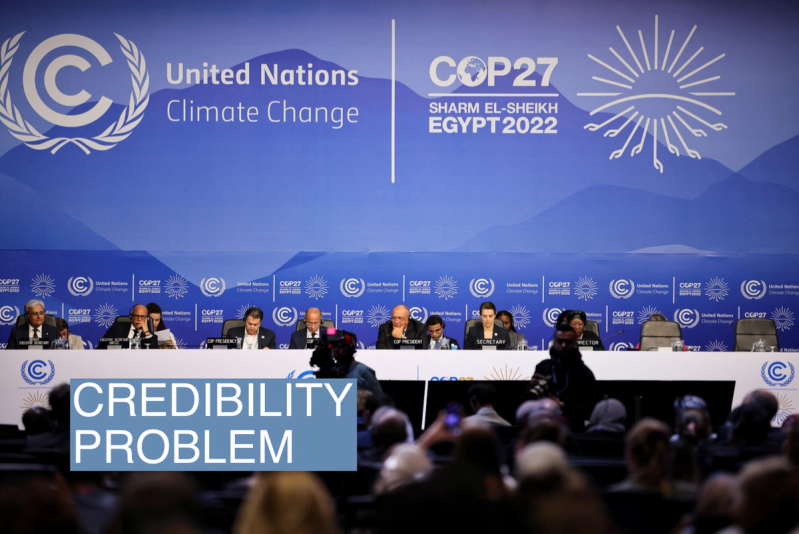The News
Failures at COP27 mean that carbon credits may play a much bigger role in decarbonization plans of countries and companies without assurances their claims of reducing emissions are real and not exaggerated.
Among the issues aimed at preventing greenwashing that were not resolved at the conference was whether countries will be allowed to conceal the details of how a credit was created and whether specific reductions can be “double counted,” or claimed by two different entities even though it happened only once.
Governments at the United Nations conference sought to negotiate rules for how countries can take advantage of the financing mechanism to raise money for projects that remove carbon from the atmosphere, prevent deforestation or head off future emissions. U.S. Climate Envoy John Kerry touted carbon credits as a way to channel tens of billions of dollars from the developed to the developing world to address climate change.
The negotiations are part of an effort — encouraged by a wave of companies, countries, and other entities aiming for carbon neutrality — to create a new system to channel money through the sale of carbon credits into preserving forests and mangroves and closing down coal-burning power plants. The credits allow the entities to pay others to remove carbon from the atmosphere or reduce emissions instead of doing it themselves, while still claiming credit for the reductions.
Global business consultant McKinsey & Company says the roughly $2 billion market for voluntary credits alone could grow 15-fold by 2030 and perhaps as much as 100-fold by 2050. Through a combination of regulation in mandatory markets and integrity strengthening in voluntary schemes, the price of credits will need to rise.
They currently range from as little as a few dollars in voluntary markets for each ton of carbon — the fundamental unit of exchange across all markets — to the high double digits in mandatory compliance markets like Europe, where the price briefly crossed $100 earlier this year. Prices hovering in the low triple digits will eventually be needed to reflect the actual cost of carbon, according to the World Bank and other analysts.
In theory, that could be a conduit to finance a big chunk of the world’s progress towards carbon neutrality, the end game where as much carbon is being pulled out of the atmosphere as is being spewed into it.

Bill’s view
An earlier, U.N.-run carbon credit initiative enabled a wave of greenwashing. That’s caused many critics to give up on offsets, altogether. But there are few ways to channel money into decarbonization on this scale, so it’s worth another attempt to get carbon markets right.
The problem is that this still isn’t happening. The Paris Agreement of 2015 offered a new approach to carbon credits, one that allows countries to harness the efforts of all countries and companies, as well as an array of other entities from local governments to philanthropists.
Over the long haul, the framework holds the potential to gradually weave together the rigor of a growing number of legally binding carbon credits trading systems — from the northeast of the United States to Europe and China — with a freewheeling and fast growing market made up of voluntary players operating under their own set of rules.
That could create an optimal combination of integrity and broad participation needed to super-size these markets to a scale that can make a dent in global carbon emissions. Efforts are under way to make that happen, but progress has been spotty so far.
Mark Carney, the former Bank of England head who started a corporate wave of decarbonization goal-setting under his Glasgow Financial Alliance for Net Zero, pushed for a massive scale-up in voluntary carbon markets. But the initiative got out over its skis early on, and efforts to expand carbon trading have regrouped around developing a set of common standards and practices that assure credits aren’t essentially greenwashing tools for buyers to make lofty claims with little or no decarbonization.
That effort, led by a former head of the U.S. Securities and Exchange Commission, has issued a set of draft guidelines that are expected to be finalized around the end of the year. So far so good.
But the negotiations at COP27 have been less encouraging. While Kerry touted possible use of “high quality” offsets to finance the decommissioning of coal plans in developing countries, the talks concerning two critical aspects of assuring quality essentially went nowhere.
The negotiators failed to agree on provisions that would bar countries from unilaterally obscuring information about some credits — undermining the transparency of the market — and prevent double-counting of the underlying decarbonization, essentially making the impact seem bigger than it actually is in the real world.
The matter isn’t settled, and wrangling will likely continue into next year’s climate summit, COP28 in the United Arab Emirates.
Room for Disagreement
Some economists dismiss the idea of carbon markets working on a voluntary basis. They argue the incentives are too strong for most market players — from project overseers that purport to remove or prevent carbon emissions, to the standards-setters that claim to guide them, the verifiers who audit them, and the end-users who buy them — to dilute the impacts in order to keep prices low and grow the market whether decarbonization really happens or not.
“There’s an economic incentive on both sides to wink and say, ‘oh, this is a good offset,“’ said Robert Stavins, an economist at Harvard University.
Still, Stavins believes that well-regulated carbon markets that are mandated — so-called compliance markets like in California, Europe and China — can be effective. That’s because the governments can enforce restrictions that force buyers to focus on actually reducing their emissions to a bare minimum before turning to offsets.
The View From China
China’s mandated carbon market began last year, initially requiring only the country’s electricity generators to participate. Even that tiny slice of greenhouse gas emitters is three times larger than those covered by the broader EU emissions trading system. If China expands the system to its steel and aluminum and other manufacturing — as it has said it eventually plans to do — the market would become three times larger than all the other carbon markets globally combined.
The standards China chooses to impose — choices being considered alongside deliberations in the West — could matter well beyond its own market. One Chinese academic with close ties to Chinese authorities told an audience at COP27 that the scheme could eventually allow companies to use voluntary offsets from abroad for up to 5% of their requirements. Those requirements could eventually reach hundreds of billions of dollars.

